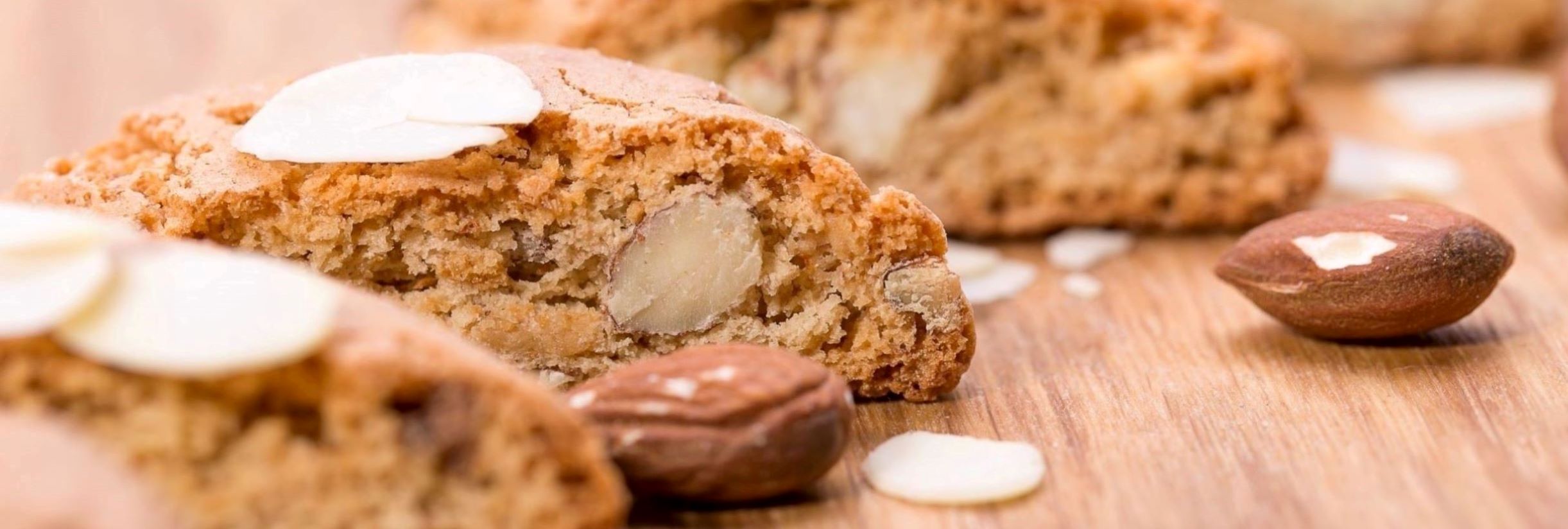
Tuscany is a land of culture, traditions and... sweetness
Every city, village, and often district hand down its secret in Tuscan cuisine, and the real masterpieces are the sweets that enrich the already inviting food and wine offer of this wonderful land. We would like to talk about some of our excellences with the ambition to reawaken the irrepressible desire to taste its flavors.
The Cantuccio is one of the typical sweets whose origin is claimed by many important Tuscan cities from Prato to Siena, to indicate the best known, and dates back to around the 16th century. For some, the name derives from "cantellus", which in Latin means "piece or slice of bread", or a salty biscuit used by Roman soldiers. For others, the term Cantuccio derives from "canto", an angle, a small part that refers to the cutting format. We find these delicious biscuits since the second half of the 1500s at the Medici court, still in the version without almonds.
About a century later the “Accademia della Crusca” elaborated the first definition of "Cantuccio" indicated as "sliced biscuit, fine flour, with sugar and egg white". Only at the end of the XXIX century, in the version, now more widespread with almonds, the Cantucci began to be produced in the whole region which in 2016 obtained the recognition of Protected Geographical Indication (IGP) referring to the entire administrative territory. The Tuscan tradition cantuccio is consumed soaking it in the Vinsanto, a sweet wine typical of the territory.
The Ricciarelli of Siena, whose history is full of charm on the edge of legend, are sweets always prepared in Siena and in the surrounding area. It is believed that their origin is closely related to marzipan and the Orient from which it arrived in the courts of Europe starting from the XXV century. But how did the marzipan set in the city of the Palio? According to the most accredited historical sources, marzipan was brought to Siena as throughout Europe by the Burmese city of Martapan and hence the origin of the name; according to others, the name of this biscuit derives from the typical containers in which it was kept in Arabic called "mauthban".
Whatever the origin of the marzipan name, you may be wondering what all this has to do with the Ricciarelli. In our story, the figure of Ricciardetto Della Gherardesca enters the scene who, according to legend, brought these sweets, "curled" in shape like the shoes of a sultan, to Siena returning from the Crusades. The recipe of these sweetnesses was handed down over the years, indeed over the centuries, enriched according to the "new" and winning Sienese version with the covering of sugar like Panforte.
According to popular tradition, the first step that led to the invention of the Copate must be attributed to the nuns of Montecelso, well known for the creation of the Panpepato as well. These ingenious sisters, having heard that the "colleagues" of the Convent of San Baronto in Lamporecchio (obviously in Tuscany...) have produced religious hosts, making them softer and pleasant with the addition of honey. These sweets, in the early times known as "nebulae", immediately deserved a place of honor on feast days for their goodness.
The definitive version of Copate, now known and appreciated, was reached with the enlightened intervention of a monk of the Abbey of Monte Oliveto Maggiore, who mixed together with sugar, honey, toasted and shredded walnuts, cooking everything over moderate heat. Once cooled, this caramelized mixture was spread between two hosts. In later versions, cocoa was added and in more recent times the whipped egg yolks made the mixture almost white.
Regarding the Panforte or Torta di Siena, rivers of ink could arise. Consumed above all at Christmas time, that irresistible mixture of almonds, honey, and spices, represents a real delight for Italians and for all those who are lucky enough to taste it. Almost certainly it is the best known and the oldest of the spiced bread and with regard to its origin, to be placed in the late Middle Ages, it is said that the first panforte was produced by Berta, a nun who prepared a flatbread by mixing honey, flour and candied fruits, along with a wide variety of spices including ginger, cinnamon, and nutmeg.
Since the Middle Ages, the recipe of the Panforte has not undergone great changes and among the most known and most appreciated variants, we remember the white one and the chocolate one. The first one, with icing sugar, was prepared for the first time in honor of Queen Margherita of Savoy who came to Siena in 1879 for the Palio and from here the dessert is also called Panforte Margherita.
The most interesting combination to discover all the flavors is with blue cheeses: it will surprise you!
And now you just need to dive into the Tuscan sweetness!
Enjoy them!
Share on:


